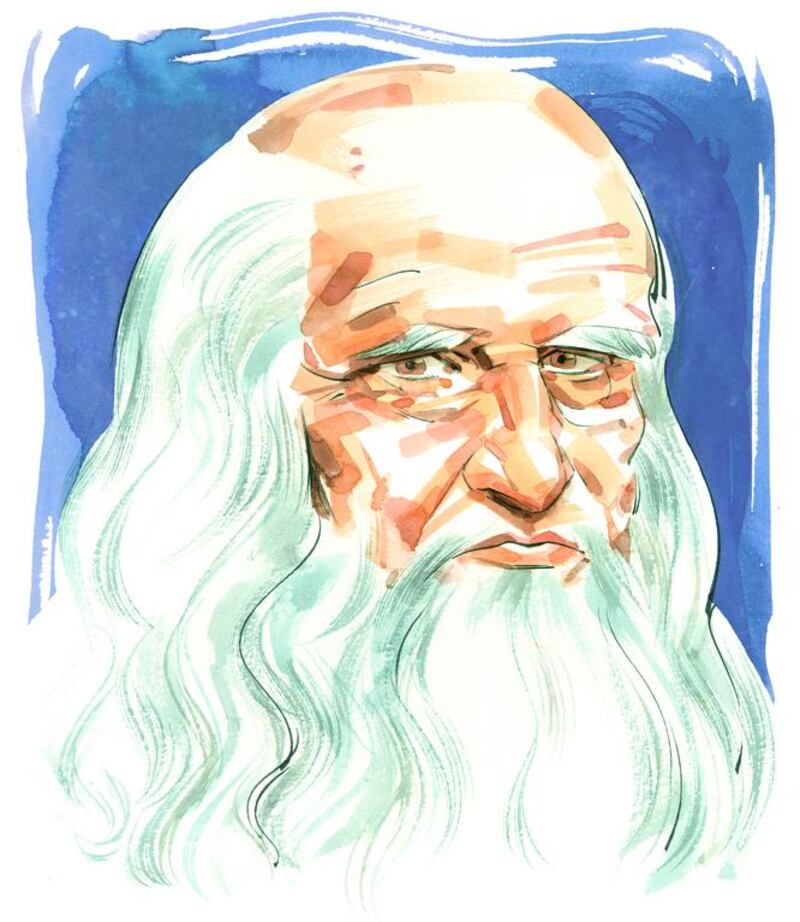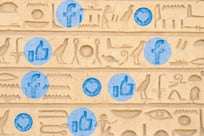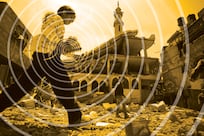History has reduced Leonardo da Vinci to a colossus. Five centuries after his death, Leonardo’s brilliance is so unconditionally accepted that appreciation and analysis are no longer necessary.
There is no better place to witness this than in the Denon wing on the ground floor of the Musée du Louvre in Paris. Here hangs the Mona Lisa, without question the most famous painting in the world, painted in the early 16th century and generally regarded as Leonardo's masterpiece (although an equal candidate would be The Last Supper).
Measuring just 77cm by 53cm and, so, rather smaller than your average flat-screen TV, the Portrait of Lisa Gherardini, wife of Francesco del Giocondo, as listed in the Louvre’s collection, hangs at the far end of a large gallery.
As protection against the criminally minded and the insane, Mona Lisa (Mona is a contraction of madonna, or lady, in old Italian) has been placed behind a sheet of bulletproof glass in a climate-controlled enclosure. The painting is hung rather too high for serious viewing, with the glass-walled enclosure and protective barrier jutting out several metres as a further obstacle to inspection. None of this matters. Despite the huge crowds that gather around her, almost no one who comes to see the Mona Lisa has a serious interest in art. Rather, the painting has an almost totemic presence; a box to be ticked on the tourist bucket list. Every day they throng, not to see the Mona Lisa but to be seen with her, holding up the cameras on their iPhones as proof.
Some even turn their backs on the lady, to create that most vacuous manifestation of early 21st-century culture, the selfie. Only this week, the Louvre generously opened its doors after-hours for those contemporary musical giants Beyoncé and Jay Z. The depressing result was a digital threesome, posted inevitably on Instagram.
It will, hopefully, be a different story with another Leonardo masterpiece, La Belle Ferronnière (Portrait of an Unknown Woman), announced this week as part of the collection of Louvre Abu Dhabi when the museum opens in 2015.
The loan will give visitors to Louvre Abu Dhabi a unique opportunity for a close study of the master’s style and technique, to reflect on one of the most brilliant minds in history, in a very different setting to the febrile atmosphere of Paris.
Long out of copyright, Leonardo da Vinci has become an easy symbolic hotkey for representing genius. He is one of the Teenage Mutant Ninja Turtles, has appeared on TV in everything from Dr Who to My Favorite Martian and Bewitched and inspired Dan Brown's best-selling The Da Vinci Code.
That old fraud Salvador Dalí appropriated the Mona Lisa replacing parts of her face with his. Nat King Cole sang about her, the Italian clothing chain Benetton borrowed da Vinci for its "United Superstars of Benetton" campaign. A species of moth and a crater on the Moon are named after him.
He has appeared in video games, as a Marvel superhero and in at least eight films. The artist's Vitruvian Man, which uses a naked man in a circle to demonstrate the ideal proportions of the human body, is rivalled in the T-shirt industry only by Che Guevara. Like Che, Leonardo is well known enough to dispense with a surname.
Yet despite this easy familiarity, Leonardo the Man is still a stranger to most of us, buried too deep to struggle out from under Leonardo the Cliché. Even Sigmund Freud, in his Leonardo da Vinci and a Memory of His Childhood (1910), got in the game, attributing, naturally, his genius to suppressed sexual trauma in infancy.
In fact, Leonardo is already 5 when he makes his first public appearance, in a tax return made by his grandfather in 1457. By then he was living in Vinci, a hill town a little to the west of Florence in a typical Tuscan farmhouse, which is now a museum and which otherwise, today, would probably be a desirable holiday home for a banker.
He was illegitimate, with some evidence that his mother, Caterina, may have been a slave captured from the Middle East and in the service of a neighbour. His father was a Florentine lawyer, Piero, whose title, ser, is a diminutive suggesting a knight. The artist’s full name is Leonardo di ser Piero da Vinci, literally Leonardo, son of Sir Piero from Vinci.
By 1466, at 14, he was apprenticed to the artist Andrea di Cione in Florence, now in the iron grip of the Medici family, bankers to the Pope, unforgiving to their enemies, but also abundant sponsors of the arts.
This was the Renaissance, the cultural rebirth that rescued Europe from the darkness of the Middle Ages. Leonardo was to become the ultimate Renaissance Man, skilled in everything he did.
By the age of 20, he was recognised as a prodigy, admitted to the guild of Florentine painters. He had already collaborated on a number of works by di Cione, also known as Verrocchio (True Eye), with his Baptism of Christ, which now hangs in the Uffizi, attributed as his earlier collaborative work. After seeing what the young Leonardo had done, Verrocchio is said to have laid down his paintbrush never to pick it up again.
In his mid-20s, Leonardo was already an established artist in his own right. The Annunciation, generally thought to date from around 1473 and also in the Uffizi, is his earliest, generally accepted painting. Numerous drawings and sketches aside, there are fewer than two dozen major works fully or partially attributed to Leonardo, including two versions of his Virgin of the Rocks, one in London, the other in Paris.
That there are so few major works often surprises. It also offers something of an insight into Leonardo the man. To complete the Mona Lisa took 10 years; The Last Supper, using a fast-drying, egg-based painting medium known as tempera, took four.
The length of these projects is attributed to Leonardo’s prevarication. He would constantly reassess projects and experiment with new techniques. Sometimes this was with disastrous effects. Very little of the original paintwork of The Last Supper survives because tempera, unlike fresco, which is laid on wet plaster and sinks several layers deep, does not well survive the ravages of time.
Worse was to befall his lost masterpiece, The Battle of Anghiari, a colossal mural of men and horses commissioned for the Palazzo Vecchio in Florence (Leonardo's patron Piero Soderini was nothing if not ambitious: the facing wall was to feature a work by Michelangelo). In the light of his experiences with The Last Supper, Leonardo experimented with a wax undercoat. Unfortunately, the paint began to drip. Despite bringing in braziers, large parts of the painting were ruined. The work was abandoned, although there is evidence that it survived at least in part under a false wall later built in the chamber.
This desire to push boundaries, to flirt with disaster, is an essential part of Leonardo’s genius. “Iron rusts from disuse; stagnant water loses its purity and in cold weather becomes frozen; even so does inaction sap the vigour of the mind,” he once wrote.
His ideas frequently burst through even the concepts of the Renaissance. In his lifetime, he was known as much as an engineer and an inventor as an artist. Many of those creations are familiar today. In his sketchbooks are detailed proposals for everything from a prototype tank to a flying machine and a parachute. Often, these ideas were conceptual rather than practical. His design for an armoured vehicle was incapable of forward movement, his hand-cranked “helicopter” would have spun uselessly on the ground.
We know little of his personal life. He never married and left no children. In his mid-20s he was accused of sodomy, but the charges were dropped. He showed affection to his pupils and apprentices, even leaving the last his Mona Lisa, but there is no evidence that his affection was anything but paternal. Many of his greatest works portray women, often mysterious and sensual even when the subject was sacred.
In old age, he sought first the patronage of Pope Leo X and finally Francis I of France, to whom he promised a mechanical lion whose chest would open to reveal a royal bunch of lilies. Leonardo died at 67 on May 2, 1519, at the Château d’Amboise in France’s Loire Valley. Francis claimed the master took his last breath in his arms, although the royal calendar shows this to be a fiction. It says much of Leonardo’s stature, even in his lifetime, that a king would make such a boast.
The only known self-portrait dates from 1512, as Leonardo turned 60. The eyes are deep-set and lonely, weary with age but full of knowledge. The mouth is downturned. He chooses not to meet our gaze.
Giorgio Vasari, the painter and art historian whose childhood overlapped Leonardo's final years, wrote in Lives of the Most Excellent Painters, Sculptors, and Architects: "Clearly, it was because of his profound knowledge of painting that Leonardo started so many things without finishing them; for he was convinced that his hands, for all their skill, could never perfectly express the subtle and wonderful ideas of his imagination."
jlangton@thenational.ae
jlangton@thenational.ae






